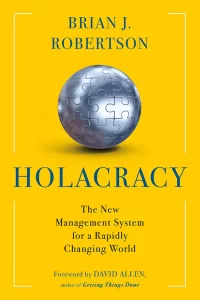Summary
This module defines a standard format for encoding the roles and circles (“teams”) of the organization, as well as basic responsibilities anyone in a role must agree to (e.g. tracking your projects/actions into some system outside of your mind). It also defines the core structural roles necessary for a circle to function, such as the Circle Lead, and defines their responsibilities and authorities.
This structure is unique, among other reasons, because it allows to define roles around the work of the company, instead of around the people. One person may therefore have multiple roles, and a same role may have several people assigned to it.
Business value
- This module alone shifts the organization to a constitutional management. As such, it allows for a standardization of how roles are recorded, which facilitates communication about the company structure and provides a great deal of transparency into who is doing what.
- Because this format allows for one person to have several roles, it allows for a better allocation of human resources when they have talents to contribute in different teams. At the individual level, it makes it easier to select roles that are a best fit for your own talents and motivation, as long as it suits to the organization’s needs.
Key Features
Below is a summary of key elements from this module. For the actual rules, please check Constitution – Article 1.
Role Definition
Defines the elements of a Role or Circle — both are defined with the same elements: a Purpose, Accountabilities, optional Domains and Policies.
Why it’s useful:
- Provides a consistent standard for defining all roles in the organization, increasing transparency and facilitating communication about who does what.
- Roles (and circles) are intended to be defined around the work, not the people. Instead of one job position, one person may have several roles, even across several circles. This allows for more flexibility of role assignment and talent matching.
Role Lead Responsibilities
Defines the responsibilities of a Role Lead (i.e. person assigned to a role) as a proactive worker expected to generate and execute on their own work, not just wait for work to be assigned by a higher up (although that is still possible, depending on the role definition).
Why it’s useful:
- Clarifies the basic expectations for anyone assigned to a role.
- Makes explicit that workers are expected to be proactive in their roles.
- Defines the org-wide requirement for everyone to maintain a written “to-do” list for their work (vs. merely keeping it in their head). This is a best practice and it sets the stage for more transparency by sharing these to-do lists (see Module 2: Rules of Cooperation). For knowledge-workers, that to-do list can take the form of a system like GTD (Getting Things Done); for others it can be a simple written list on a personal document or even a collective board.
Circle Properties
Defines a Circle as a role that contains other roles. As a result, a circle has some additional properties but otherwise has the same definition and format as a role.
Why it’s useful:
- Groups roles together under the same purpose, enabling a scalable structure. While it may be useful to refer to a circle as a “team”, note that a circle is not a group of people. It is a group of roles (i.e. organizational functions), and the people assigned to these roles may have roles in other circles.
- Defines structural roles for each circle in order to effectively “run” the circle as a circle: a Circle Lead, Facilitator, and Secretary. These roles are not full time jobs, but necessary functions in every circle.
Circle Lead Responsibilities
Defines the role of “Circle Lead” for a circle, its specific authority and responsibilities:
- Authority to assign people to the roles within the circle.
- Responsibility for any role of the circle that is not assigned to someone else.
- Authority and responsibility to define priorities and strategies for the circle.
Why it’s useful:
- Enables a link between a circle and its sub-circle.
- Encodes management best practices through its strict set of authority and responsibilities.
- Separates the functions of managing the work and managing the people. A Circle Lead is focused on managing the work. While this role may look like a “manager” to a superficial reader, its responsibilities and authorities are strictly limited. For example, this definition says nothing about promoting people, hiring, firing, or setting compensations. These “people-related” functions need to be defined separately.
Alternative to Holacracy’s Organizational Structure
If you choose not to adopt the Holacracy Organizational Structure module, you are essentially not adopting Holacracy at all. All other modules of the Holacracy constitution rely on the role structure defined in this first module. They simply wouldn’t make sense without the role structure as a foundation.
Typical alternatives to Holacracy’s Organizational Structure are: the ubiquitous conventional management hierarchy, where authority is vested in people based on their rank and job title. Or, in rare cases, more flat management models (e.g. Valve, Morning Star, etc.).
